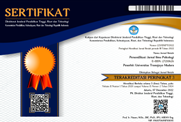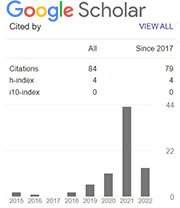Hardiness pada Penderita Kusta
Abstract
This study aims to reveal the hardiness of leprosy patients in the village of Tanjung Kenongo, Sumber Glagah sub village, Mojokerto. This study uses qualitative research with case study approach. Subjects in this study are two with purposive sampling techniques and methods of collecting data using semi-structured interview technique. Analysis technique used in this study is a model of Miles and Huberman include data collection, data reduction, data presentation, and conclusion. The result of the research show that the leprosy patients filled showed by 3 aspect of hardiness. The first that control aspect, leprosy patients can control them self and influence all events that happened in their life with accept the reality and be patient of their hardships of life. Second that commitment aspect, the leprosy patients can involve them self to the society with following the social activity and found the meaning of their event in their life. Last that challenge aspect, the leprosy patients with the physical limitations can help the family economic and showed the attitude if they want have better relationship with their family that refuse them.
Keywords: Hardiness, the leprosy patient, Sumber Glagah sub village
Full Text:
PDF (Bahasa Indonesia)References
Buku
Ammiruddin, M. D. (2012). Penyakit Kusta Sebuah Pendekatan Klinis. Sidoarjo: Brilian Internasional.
Bishop, G. D. (1994). Health psychology: Integrating Mind and Body. Boston: Allyn and Bacon
Ghufron, M, N dan Risnawita, R. (2011). Teori-Teori Psikologi. Jogjakarta: AR-Ruzz Media.
Harahap, M. (2000). Ilmu Penyakit Kulit. Jakarta: Hipokrates.
Hurlock, E. B. (1980). Psikologi Perkembangan Suatu Pendekatan Sepanjang Rentang Kehidupan. Edisi Kelima. Jakarta: Erlangga.
Kementrian Kesehatan Republik Indonesia. (2016). 2015 Profil Kesehatan Indonesia. Jakarta: Kementrian Kesehatan RI
Moleong, L. J. (2012). Metode Penelitian Kualitatif. Bandung: PT Remaja Rosdakarya
Sarafino, E. P. (1994). Health Psychology. Biopsychosocial Interaction. USA: Published Simultaneously in Canada.
Smith, J. (1993). Understanding Stres and Coping. USA: Macmillan Publishing Company.
Sugiyono. (2013). Metode Penelitian Kuantitatif Kualitatif dan R&D. Bandung: Alfabeta.
Jurnal
Astutik K & Dodik A. A. 2012. Hubungan Antara kepribadian Hardiness Dengan Stres Kerja Pada Anggota Polri Bagian Operasional di Polresta Yogyakarta. Jurnal Psikologi Vol. 10. No. 01.
Desi, A. R. 2012. Dukungan Psikososial Keluarga Penderita Kusta Di Kabupaten Pekalongan. Seminar Hasil Penelitian. ISBN : 978-602-18809-0-6.
Ekowarni, E. 2001. Pola Perilaku Sehat dan Model Pelayanan Kesehatan Remaja.Jurnal Psikologi. No. 2, 97-104.
Iqbal, A B & Siti I S. 2014. Perjalanan Hidup Penderita Kusta dalam Mencari Penerimaan Diri. Vol. 03. No. 2.
Ryff D and Singer H. 2008. Know Thyself and Become what you are: A Eudaimonic Approach to Psychological Well-Being. Journal of Happiness Studies, Vol. 39 (No. 10902-006-9019-0 Hal :20-23)
Uyun, Q & Rumiani. 2012. Sabar dan Shalat Sebagai Bentuk Model Untuk Meningkatkan Resiliensi di Daerah Bencana Yogyakarta. Jurnal Intervensi Psikologi. Vol. 4. No. 2.
Soedarjatmi, T.I., & Laksmono W. 2009. Faktor-Faktor yang Melatarbelakangi Persepsi Penderita Terhadap Stigma Penyakit Kusta. Jurnal Promosi Kesehatan Indonesia. Vol. 4. No. 1.
Uyun, Q & Rumiani. 2012. Sabar dan Shalat Sebagai Bentuk Model Untuk Meningkatkan Resiliensi di Daerah Bencana Yogyakarta. Jurnal Intervensi Psikologi. Vol. 4. No. 2.
Shobihah, I. F. 2014. Kebersyukuran (Upaya Membangun Karakter Bangsa Melalui Figur Ulama). Jurnal Dakwah. Vol. XV. No. 2.
Sumber lainnya
Rumah-sakit.findthebest.co.id/l/842/RS-kusta-sumberglagah. (Diakses 20 September
DOI: https://doi.org/10.21107/personifikasi.v8i2.3858
Refbacks
- There are currently no refbacks.
Copyright (c) 1970 Denny Elvan Ardhi

This work is licensed under a Creative Commons Attribution 4.0 International License.


Personifikasi by Universitas Trunojoyo Madura is licensed under a Creative Commons Attribution 4.0 International License.










